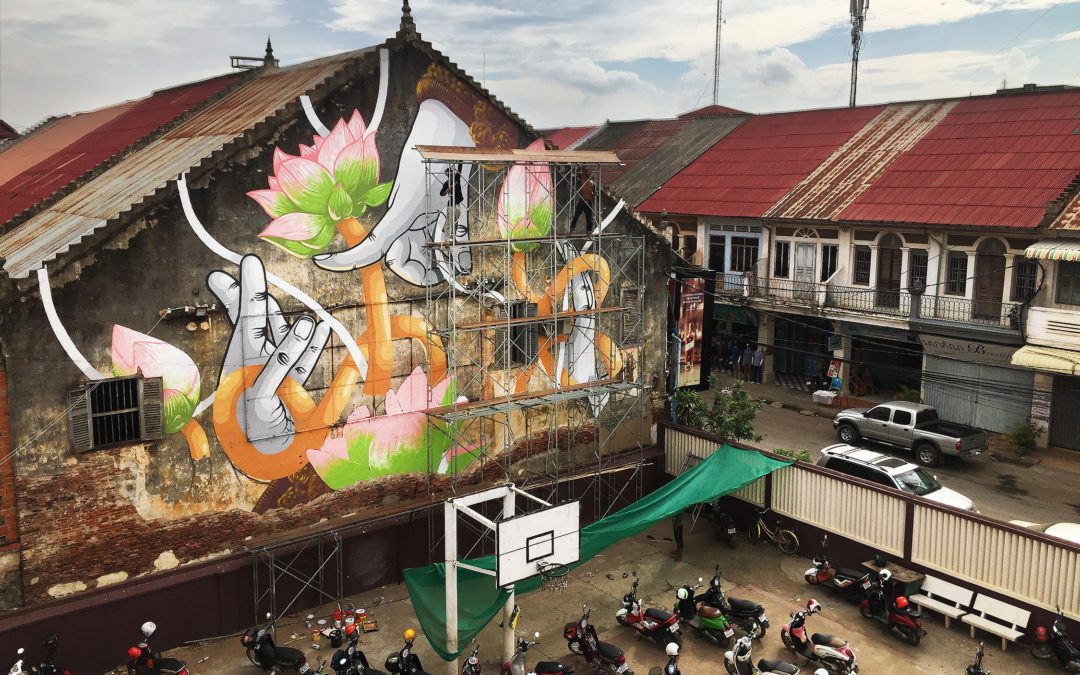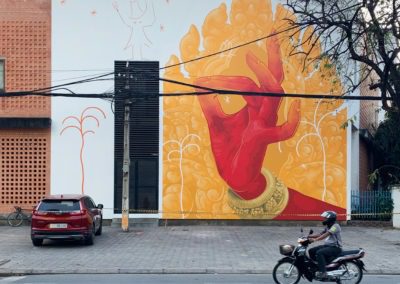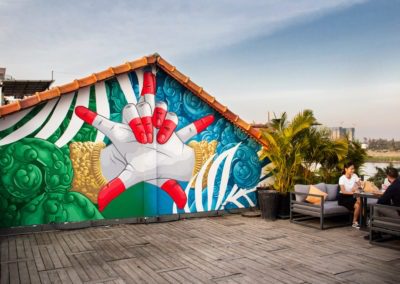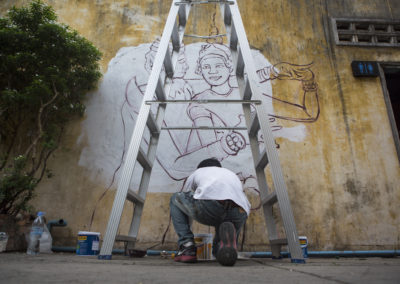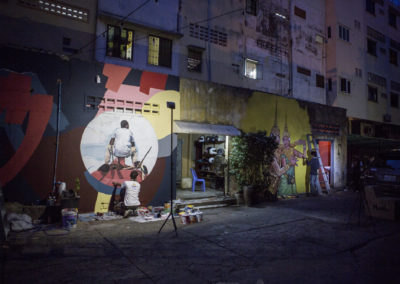Chifumi painting his mural in 2019, Battambang, Cambodia.
Back in 2019, I spent several days watching a massive mural being painted on a wall in Battambang, Cambodia. The artist, high up on scaffolding, was Chifumi Krohom. The electric energy of the S’Art Urban Art Festival bounced off the surrounding streets, pulsating with music, laughter, and children’s chattering. Enthusiasm, awe, and curiosity were as thick as the relentless hot sun. It was a revival of the finest sorts, and I was mesmerized.
This was more than watching a man painting on a wall – it was a captivating performance. Chifumi, using his signature images of giant hands, was transforming a space infusing symbolic elements of the territory. He created a journey whereby viewers could decipher history and culture through a visual vocabulary.
Watching Chifumi was as memorable as the day in my youth when my father brought home part of the painted walls from the 1965 Watts riots in Los Angeles. The wooden panels adorned our backyard until time and weather debilitated them. After that, they never stopped speaking to me.
Street art is the vivid activity of time traveling. It is the presence of living history with all its travails, suffering, injustice, and celebration.
The golden age of the Khmer empire lasted between the 9th and 14th centuries. The Khmer Rouge killed over a third of the population in the 1970s and left the country bereft of nearly everything – especially the artists. However, the resurrection is happening, and street artists are significant players. After the prolonged Covid shutdown, urban art is stronger than ever, with new artists experimenting alongside their mentors.
Street art in Cambodia started gaining popularity in the late 2000s and early 2010s as young Cambodian artists began experimenting with the art form. Inspired by international street artists, they began to use the city’s walls as their canvas, addressing social and political issues through their work. Frequently it was not well received. Miles “El Mac” MacGregor’s massive portrait of a resident in Phnom Penh’s historical White Building was destroyed in 2015. Officials declared that Moen Theary, the resident seamstress, was not a worthy subject for art. The White Building is now a 2022 film, a moving masterpiece by Kavich Neung.
Finally, the government is showing its support, and the private sector commissions street artists for projects.
The French artist Chifumi founded the Cambodia Urban Art Festival and made Cambodia his home. His monumental-scale murals appear throughout the globe, including Croatia, Asia, Europe, India, and Nepal. His dedication to the country helped form the base for street art and activate awareness for the government to take it seriously and stop whitewashing murals.
Théo Vallie, another amazing French muralist, moved to Cambodia in 2007 and focused on working with the youth to learn the craft. He joined Chifumi in launching the Cambodia Urban Art Festival, which began in April 2015.
Chifumi graciously provided me with the photographs below.
Kbach is a traditional Cambodian style of art and design known for its intricate and decorative patterns. The style uses repetitive and symmetrical shapes, such as leaves, flowers, and mythical creatures. The designs are often arranged in a geometric and stylized manner. They are used to decorate various objects, including textiles, ceramics, and architecture.
In recent years, the Kbach style has been adopted by some Cambodian street artists and incorporated into their street artworks. In these works, the traditional Kbach patterns are often reinterpreted and combined with other elements, such as pop art, graffiti, and hip-hop influences, to create bold and visually striking murals.
Renowned street artists worldwide frequently join Khmer artists, and now powerful murals can be found in Phnom Penh, Battambang, Siem Reap, and even villages throughout the country of now 17 million people.
FONKI is one of those who returned to his Cambodian roots after his refugee parents raised him in France and Canada. He became a teenage graffiti artist in Montreal. Awareness changed his perspective on life and art in 2012 after spending time in Cambodia. “How can you understand yourself if you don’t know the past?” he asks in his award-winning moving film The Roots Remain. He moved to Cambodia and is actively building the street art community and bringing prominent muralists from all corners of the world to paint and encourage young Khmer people to join them. FONKI was the first to introduce KBach-style graffiti. Now he is world-renowned for his canvas work as well as public art. However, prestige has not corrupted his sincerity or mission to assist in returning Cambodia to its former glory. He was a host and crucial player in the 2022 Murals for Cambodia Festival. (link) and has invested his time and resources into actively building a robust art and music scene to attract the youth. This is crucial to Cambodia’s future since over 65% of the population is under 30 years old.
Watching The Roots Remain offers a powerful window to embrace street art’s importance to Cambodia’s future generations. It will introduce you to the early poets and pioneers creating a new nation. You will feel their pain, their reverance, and their commitment.
The pioneer Lisa Mam paved the way for young Khmer women and girls to get involved in local street art. Although she drew from early childhood, it was not until she was 21 that she took her talents seriously. Her work is rich in Khmer influences, and she plays with Apsara dancing goddesses appearing as stone-carved sculptures in the Angkor temples as potent symbols of femininity and women’s power. She is collaborating with the Australian-Khmer artist Peap Tarr. Tarr is integral to reviving Cambodian art and culture and deserves his public admiration. Together they are expanding into several art and design niches.
The recent 2022 Murals for Cambodia Festival brought a large cast of Khmer and international artists together, each producing gorgeous art throughout Phnom Penh. The three-day festival was held at Factory Phnom Phnom (a massive mixed-use creative hub dedicated to creating the next generation of artists and entrepreneurs) and FT Gallery, which FONKI owns. Ten renowned artists participated, including Kimsan Sou, Ryssa, Tones, Mauy MSV, Nap MSV, YSK Mike, Venks, JB Carraro, and Twoone. These artists came from Cambodia, Holland, Switzerland, Thailand, the United Kingdom, France, Japan, and Nepal. Information about these artists can be found on Murals for Cambodia Festival’s Facebook Page.
The list of artists now exploring urban art in Cambodia is creating a new generation of artists, including many students from the unique Phare Ponleu Selpak School in Battambang, where street art is abundant. Thanks to Tribe Art Gallery, visitors are welcomed by a mural on their circus building by the infamous Fin DAC. The vibrant and strong masked female figure is adorned with intricate golden Khmer jewelry and lovingly named ANAPYABAL.
KBach Arts are now zealously supporting and encouraging Urban Art in Phnom Phen. Even in rural areas, voices are rising to express themselves.
Street art aids in the process of healing the melodrama that cultures pass on to future generations.
The naysayers are plentiful. They fail to understand that street art is a testimony of individuals bravely expressing their experiences and emotions – and doing so for the greater good – for connection. Street art’s roots trail back into the long, long ago.
Just after the French Revolution ended, graffiti in the United States began to pop up on railroad boxcars. Heading into the 20th century, particularly in the midst of the Great Depression, graffitied boxcars grew in numbers as drifters, who often wrote on the sides of the cars, rode the railroads from coast to coast. In the 20s and 30s, gangs that used graffiti were on the rise in southwestern cities in the US, like Los Angeles. During World War II, soldiers found comradery through a graffiti-esque tag that read ‘KILROY WAS HERE!’ and was commonly accompanied by a drawing of a long-nosed man peering over a wall.
Though graffiti was happening in various parts of the world in rather humble ways, the reasons behind them were communal and persist in graffiti today. They were a form of making sure that your presence, however minuscule it might feel, would be known by someone.

